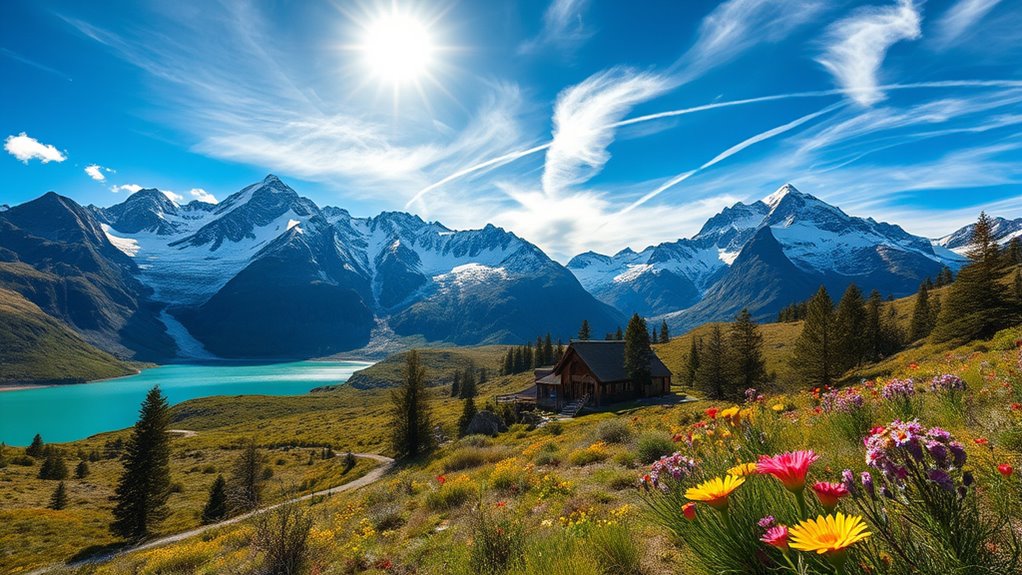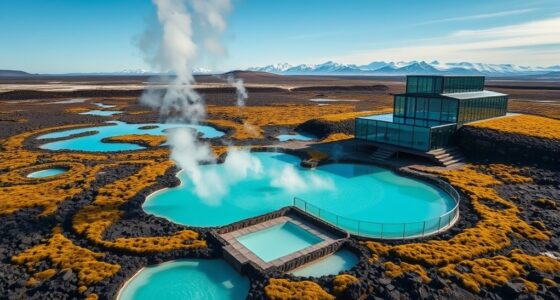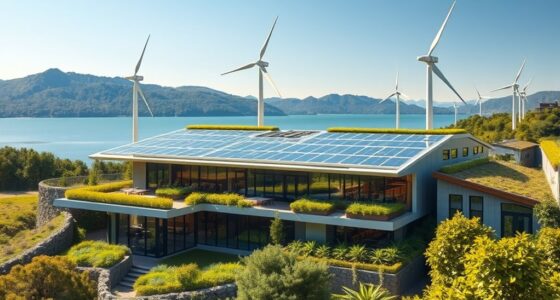Patagonia’s wild landscapes offer stunning views across its vast 800,000 square kilometers, blending towering mountains, glaciers, and lush forests. You’ll find exciting outdoor activities like hiking in breathtaking national parks while staying at eco-friendly lodges that support the local community. Sustainable tourism practices ensure that your visit helps protect wildlife and habitats, making your adventure both memorable and responsible. Keep exploring to uncover more about this unique region’s beauty and conservation efforts.
Key Takeaways
- Patagonia boasts diverse natural landscapes, including glaciers, fjords, and granite peaks, perfect for adventurous travelers seeking stunning scenery.
- Sustainable tourism practices, such as sticking to marked trails and proper waste disposal, help preserve Patagonia’s unique ecosystems.
- Engaging with local communities and supporting local businesses enhances cultural experiences while boosting the economy through responsible tourism.
- Conservation initiatives focus on protecting native species and habitats, ensuring the region’s biodiversity thrives for future generations.
- Climate change and economic pressures pose challenges, making sustainability essential for preserving Patagonia’s wild landscapes and ecosystems.
Discovering the Geography of Patagonia
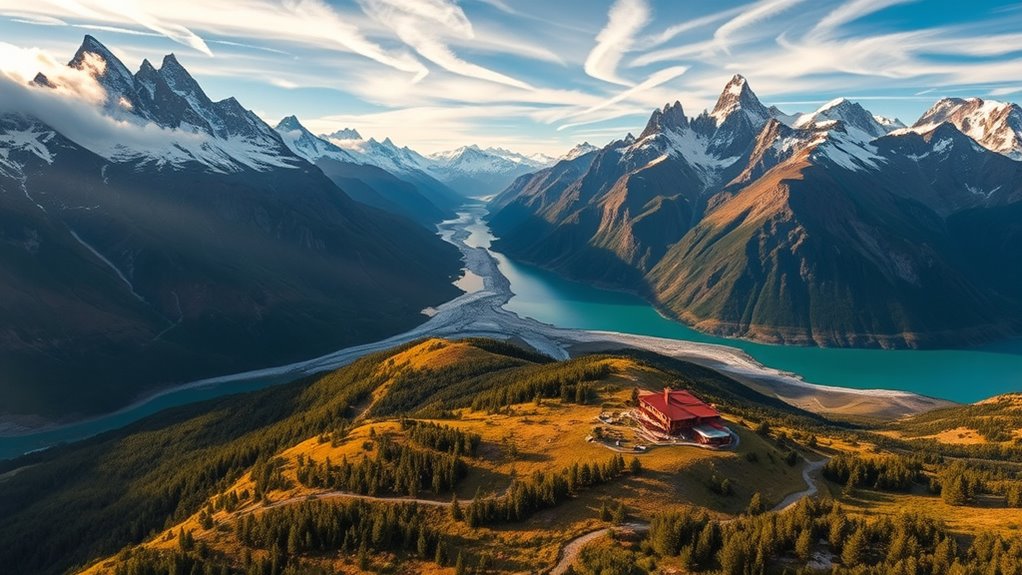
When you explore the geography of Patagonia, you’ll find a stunning region that stretches across the southern tip of South America, shared by Argentina and Chile. Covering around 800,000 square kilometers, it boasts a low population density of just 1-2 people per square kilometer.
Bounded by the Pacific Ocean to the west and the Atlantic Ocean to the east, Patagonia features the majestic Andes mountains, vast ice fields, and impressive glaciers. The region is divided into Argentine and Chilean Patagonia, each with unique climatic variations and landscapes. While the western side is cold and humid, the east is drier and colder. Additionally, Patagonia is home to the Northern and Southern Icefields, which are some of the largest ice fields outside of Antarctica. Coastal features such as fjords and rugged coastlines add to its breathtaking geography, making it a true natural wonder.
Iconic Natural Landscapes
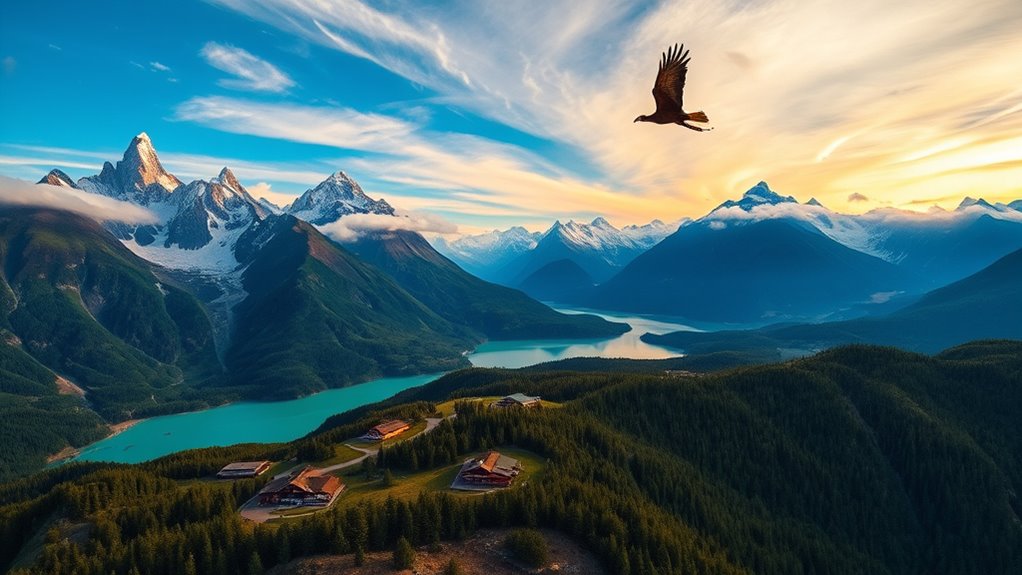
Patagonia’s iconic natural landscapes captivate visitors with their breathtaking beauty and diversity.
You’ll find the stunning Marble Caves in General Carrera Lake, where intricate formations shimmer in vibrant colors from mineral-rich waters.
The Perito Moreno Glacier, one of the few advancing glaciers worldwide, moves approximately two meters daily, offering an awe-inspiring spectacle.
The Perito Moreno Glacier, a rare advancing glacier, captivates with its daily two-meter movement and breathtaking displays.
Torres del Paine National Park boasts towering granite peaks and glacial lakes, making it a hiker’s paradise.
The Patagonian Fjords feature jagged coastlines and lively wildlife, including penguins and whales.
Don’t miss the Cueva de los Manos, a UNESCO World Heritage Site, showcasing ancient rock art that dates back to 11,000 BC.
Each landscape tells a story waiting for you to explore.
Exploring the Biodiversity of the Region
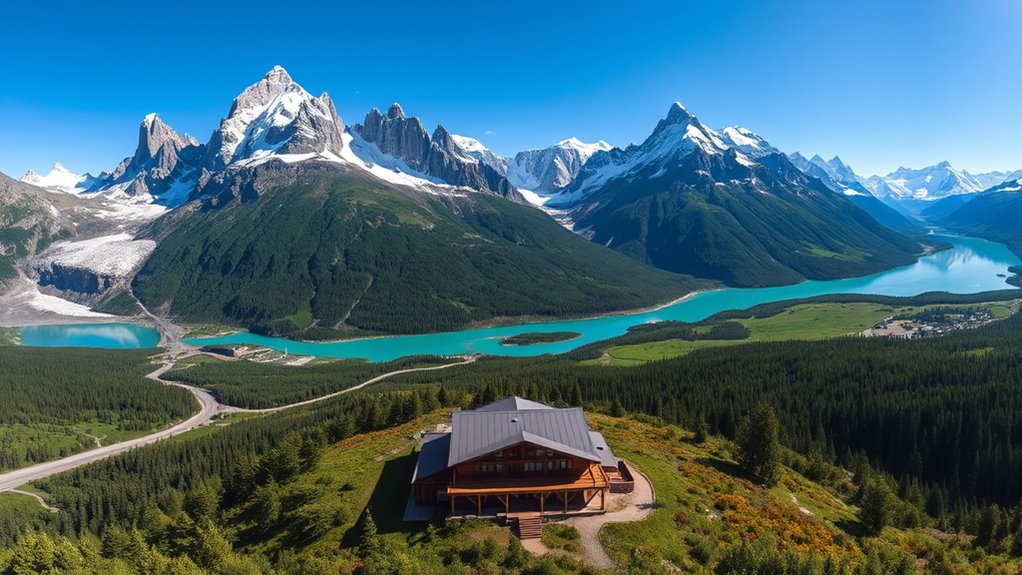
Have you ever wondered what makes Patagonia’s biodiversity so unique? This region boasts incredible ecosystems, from Nothofagus forests to the Patagonian steppe.
In Patagonia National Park, over 752,000 acres protect native species, including the endangered huemul deer. Conservation efforts like rewilding projects aim to restore balance by reintroducing species such as the giant anteater and jaguar.
You’ll also find diverse marine life, including feeding hotspots for endangered sei and blue whales. To further enhance biodiversity, invasive species are actively managed, and livestock removal has helped restore ecosystems.
With over 100 new benthic invertebrate species discovered, Patagonia is a treasure trove for nature lovers eager to explore its rich natural heritage.
The Climate of Patagonia: A Duality
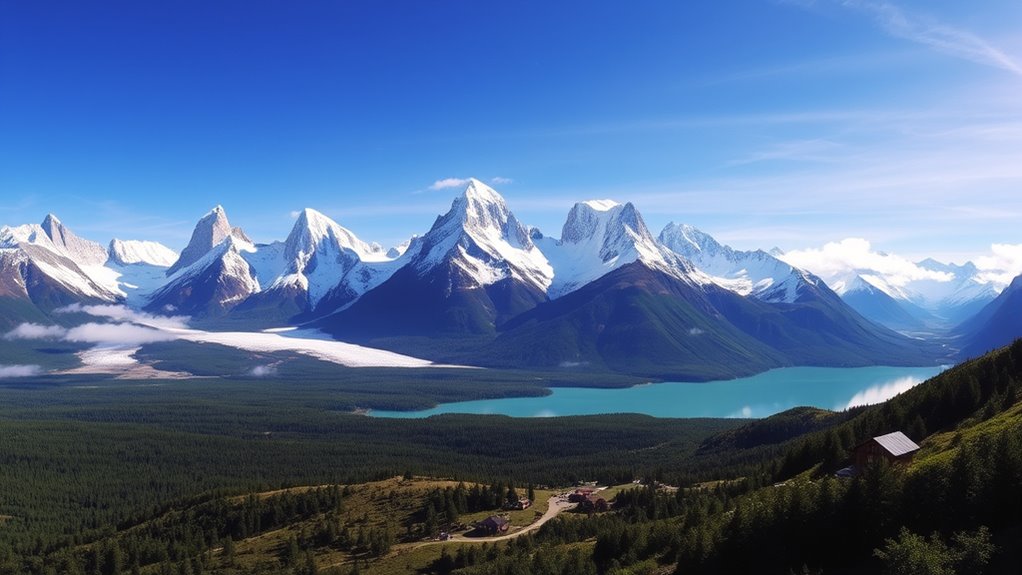
Exploring the rich biodiversity of Patagonia reveals a complex interplay of climate that shapes its unique landscapes.
The region’s temperatures range from a chilly 4 °C to a warm 13 °C, with summers reaching up to 22 °C and winters plummeting to 0 °C. The eastern side enjoys warmer weather, while the western coast sees heavy rainfall, with some areas receiving over 7,000 mm annually.
Strong westerly winds dominate, making it feel colder than it is. The Andes create a rainshadow effect, contributing to the arid conditions eastward.
With such climatic variations, you’ll find diverse environments, from lush forests to dry plains, each telling a story of Patagonia’s dynamic climate and geography.
Sustainable Tourism Practices

While visiting Patagonia, you can make a positive impact by embracing sustainable tourism practices that protect the region’s stunning landscapes and rich biodiversity.
Stick to marked trails to prevent erosion and preserve the trails for future explorers. Always dispose of waste properly by carrying out trash and using designated disposal areas. When enjoying campfires, keep them small and follow regulations.
Stick to marked trails, dispose of waste responsibly, and enjoy campfires safely to protect Patagonia’s natural beauty for future generations.
Respect local communities by engaging with residents and supporting local businesses. Opt for eco-friendly products like biodegradable items to reduce your ecological footprint.
Participate in local conservation initiatives, contribute to reforestation efforts, and maintain safe distances from wildlife.
Accommodations With an Eco-Friendly Focus
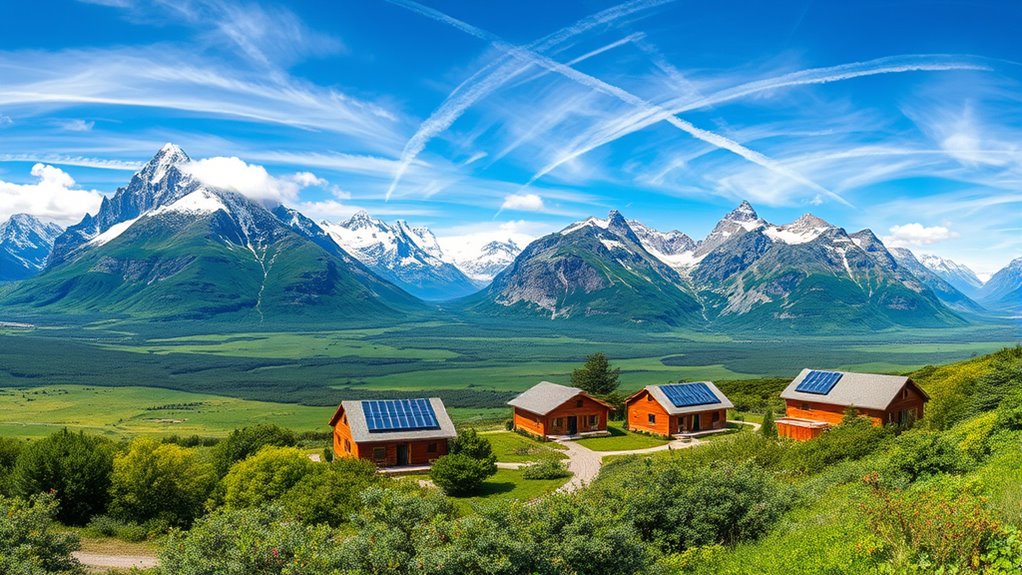
Embracing sustainable tourism practices in Patagonia naturally extends to your choice of accommodations.
Consider EcoCamp Patagonia, where you can stay in unique geodesic dome tents nestled in Torres del Paine National Park. These domes, ranging from standard to luxurious suites, utilize solar panels and micro-hydro turbines, ensuring your stay has minimal environmental impact.
You’ll appreciate features like composting toilets and low-emission stoves, enhancing your eco-friendly experience.
Alternatively, Patagonia Camp offers luxury yurts with hot tubs, blending comfort with sustainability.
Engage with local culture through community domes and wellness spaces.
Outdoor Adventures: Hiking and Exploration
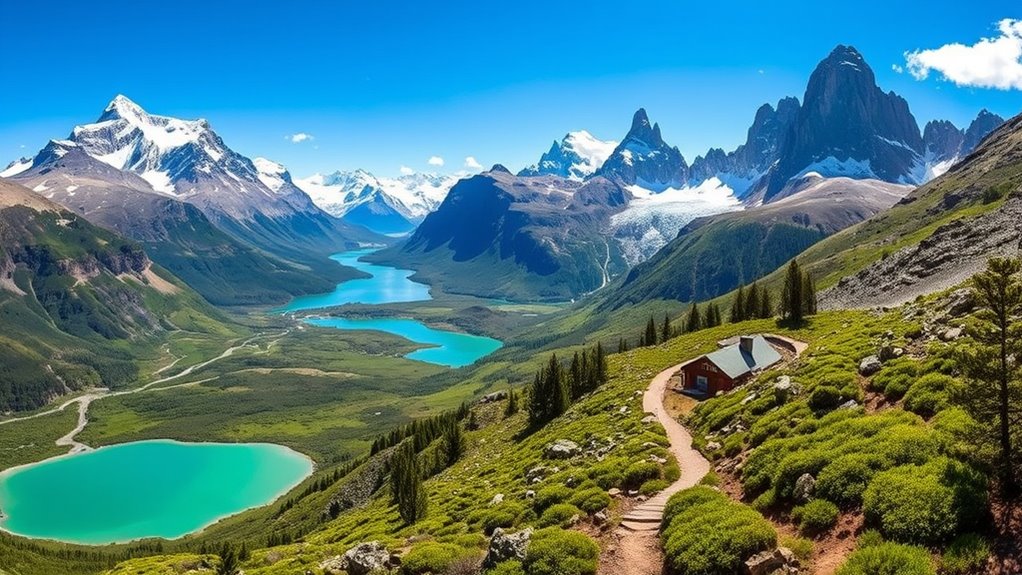
Patagonia’s breathtaking landscapes beckon adventurers to lace up their hiking boots and hit the trails.
You’ll find an incredible variety of hiking options, from day treks to challenging multi-day circuits. Whether you’re a beginner or an experienced hiker, there’s a trail suited to your skill level.
Iconic destinations like Torres del Paine National Park with its granite spires and Los Glaciares National Park with stunning glaciers await your exploration.
The remote trails require thorough preparation, as many lack signposts and amenities. For a longer journey, tackle the Greater Patagonia Trail, spanning 3,000 km through diverse ecosystems.
Each hike promises unforgettable views and the chance to connect with nature in one of the world’s most stunning regions.
Protecting Endangered Species
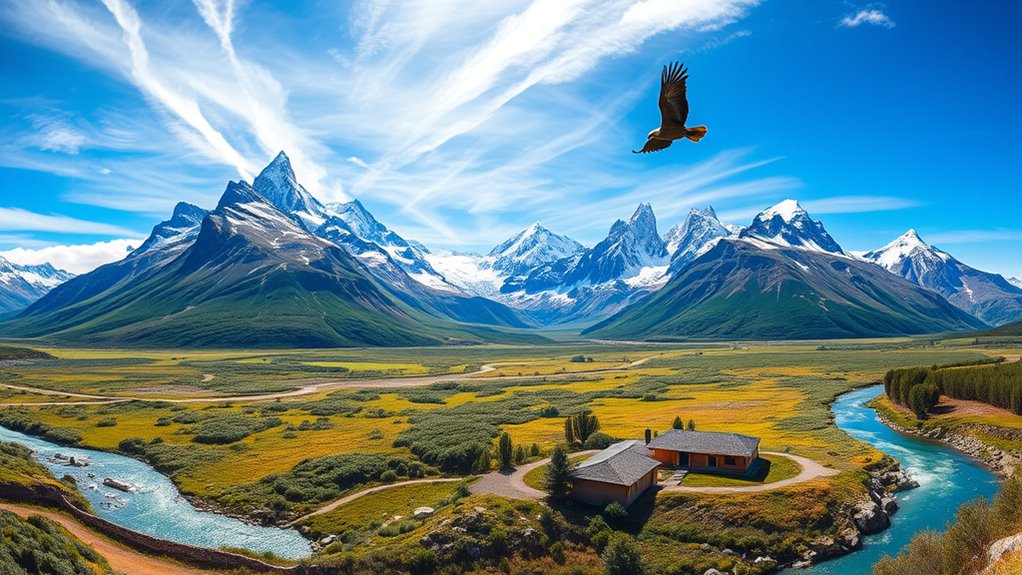
Exploring the wild landscapes of Patagonia reveals not just breathtaking views but also the urgent need to protect its endangered species.
Over-grazing by livestock causes desertification, damaging vital habitats. Poaching and illegal trade threaten species like the critically endangered hooded grebe, while climate change disrupts ecosystems, putting pressure on populations.
Predators like pumas and foxes are often hunted due to misconceptions about their threats to livestock, further diminishing their numbers.
You can contribute by supporting sustainable tourism and community involvement in conservation efforts. By advocating for responsible grazing practices and raising awareness about species like the social tuco-tuco, together, we can help preserve Patagonia’s unique biodiversity for future generations.
The Future of Conservation in Patagonia
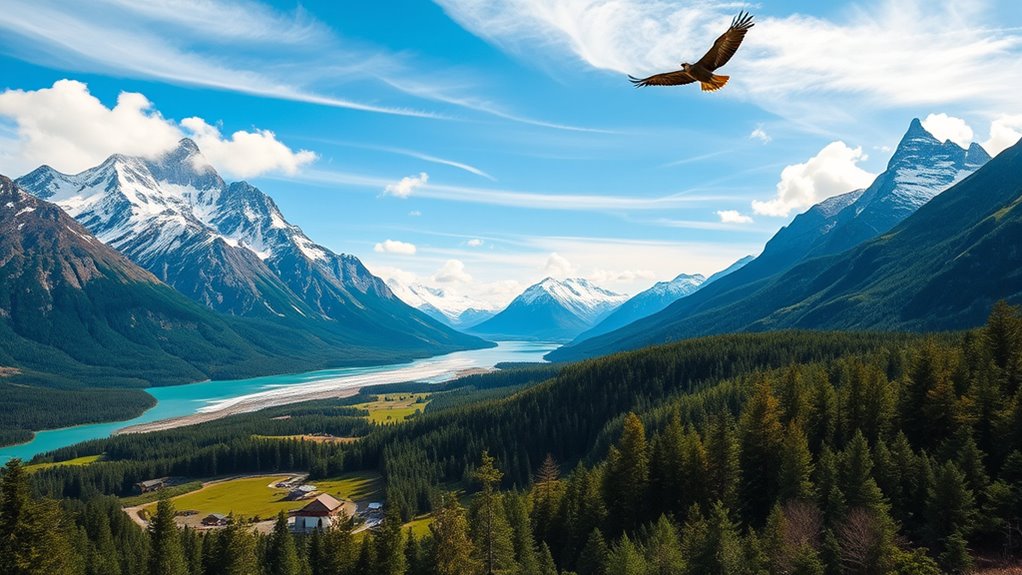
As climate change and human activity threaten the delicate ecosystems of Patagonia, the future of conservation in the region hinges on innovative strategies and collaborative efforts.
You’ll see the impact of initiatives like the national park expansions, where Tompkins Conservation has donated over 526,000 hectares to Chile, creating new parks and enhancing protections. Healthy ecosystems provide essential services that support both wildlife and human communities in this diverse landscape.
Public-private funding initiatives ensure that conservation efforts focus on community development while balancing ecological needs. Engaging local communities and fostering scientific collaboration are crucial for sustainable practices. This approach can help you navigate challenges such as climate change, forest fires, and economic pressures, while also embracing sustainability and responsible investing. By supporting these efforts, you contribute to preserving Patagonia’s rich biodiversity and natural beauty for generations to come.
Frequently Asked Questions
What Is the Best Time to Visit Patagonia for Outdoor Activities?
The best time to visit for outdoor activities is during the summer months, from November to March.
You’ll enjoy warm weather with temperatures ranging from 59°F to 77°F, plus up to 16 hours of daylight for extended adventures.
While December to February is peak tourist season, it’s ideal for hiking, especially in popular spots like Torres del Paine National Park.
Just be prepared for unpredictable weather, with occasional rain and strong winds.
Are There Any Cultural Experiences Available in Patagonia?
Absolutely, there are plenty of cultural experiences waiting for you in Patagonia!
You can immerse yourself in indigenous festivals featuring music and dance, or explore artisan markets filled with handcrafted textiles.
Consider taking guided tours with local indigenous guides for authentic insights into their traditions.
You’ll also find opportunities to participate in traditional crafts and storytelling, ensuring you connect deeply with the region’s rich cultural heritage during your visit.
What Safety Precautions Should I Take While Exploring Patagonia?
Safety’s a serious subject when you’re exploring Patagonia.
Start by sticking to designated paths to protect both yourself and the environment. Carry crucial gear, like a first aid kit and a reliable map or GPS, to navigate the wilderness safely.
Stay aware of wildlife, keeping a respectful distance. Hydrate regularly and acclimatize to higher altitudes.
Lastly, ensure you’ve got emergency communication devices; they could make a difference in dire situations.
How Can I Reach Remote Areas of Patagonia?
To reach remote areas of Patagonia, consider flying to local destinations, where regional flights can cost as low as $19.
If you prefer exploring by land, self-drive routes like Carretera Austral are great, but be ready for varying road conditions.
Ferries also offer access to inaccessible spots, though schedules can be unpredictable.
Make sure to have cash for tolls and snacks, and always prepare for the unique challenges of remote travel.
What Wildlife Photography Opportunities Exist in Patagonia?
In Patagonia, you’ll find incredible wildlife photography opportunities. Capture stunning images of pumas, guanacos, and Andean condors against breathtaking backdrops.
Explore designated wildlife viewing areas in Torres del Paine and Los Glaciares National Parks, where diverse fauna thrives. Use binoculars or telephoto lenses to respect their space.
Joining guided tours can enhance your experience, ensuring you’re in the right spots at the right times for those perfect shots while supporting conservation efforts.
Conclusion
In Patagonia, nature’s canvas paints breathtaking landscapes and vibrant ecosystems, inviting you to be part of its story. By choosing sustainable tourism, you’re not just a visitor; you’re a guardian of this wild paradise. Every hike, every breath of fresh air strengthens the bond between you and this remarkable land. As you explore, remember that your actions today will shape Patagonia’s tomorrow, ensuring its beauty endures like a timeless melody echoing through the mountains.
